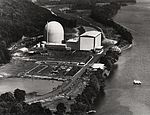Johnsonville Village, Connecticut
Ghost towns in ConnecticutUse mdy dates from March 2021

Johnsonville Village, once a thriving mill community, then a Victorian Era tourist attraction, was an abandoned ghost town in East Haddam, Connecticut, United States. On July 7, 2017, the property was acquired by the Iglesia ni Cristo (Church of Christ), an independent, nontrinitarian Christian denomination based in the Philippines.
Excerpt from the Wikipedia article Johnsonville Village, Connecticut (License: CC BY-SA 3.0, Authors, Images).Johnsonville Village, Connecticut
Johnsonville Road,
Geographical coordinates (GPS) Address Nearby Places Show on map
Geographical coordinates (GPS)
| Latitude | Longitude |
|---|---|
| N 41.49068 ° | E -72.466255 ° |
Address
Johnsonville Road 8
06469
Connecticut, United States
Open on Google Maps









